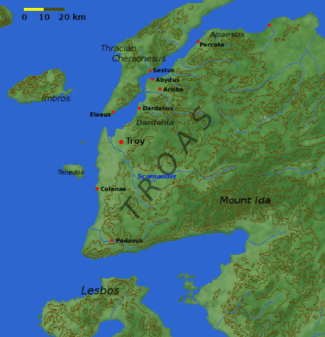Troad
| Troad | |
|---|---|
| Ancient Region of Anatolia | |
|
Part of the walls of Troy | |
| Location | Northwestern Anatolia |
| Historical capital | Troy |
| Roman province | Asia |

The Troad (/ˈtroʊˌæd/ or /ˈtroʊəd/) or Troas /ˈtroʊəs/ is the historical name of the Biga peninsula (modern Turkish: Biga Yarımadası, Ancient Greek: Τρῳάς) in the northwestern part of Anatolia, Turkey. This region now is part of the Çanakkale province of Turkey. Bounded by the Dardanelles to the northwest, by the Aegean Sea to the west and separated from the rest of Anatolia by the massif that forms Mount Ida, the Troad is drained by two main rivers, the Scamander (Karamenderes) and the Simois, which join at the area containing the ruins of Troy.
Mount Ida, called by Homer “many-fountain” (πολυπίδαξ), sourced several rivers, among them, Rhesos, Heptaporos, Karesos, Rhodios, Grenikos (Granikos), Aesepos, Skamandros, and Simoeis [Iliad 12.18 ff]; these rivers, being a source of life, were deified by the Greeks, who depicted them on their coins as river-gods reclining by a stream and holding a reed.
History
The Troad gets its name from the Hittites' name for the region, Taruiša.[1] This identification was first put forth by Emil Forrer, but largely disputed by most Hittite experts until 1983 when Houwink ten Cate showed that two fragments were from the same original cuneiform tablet and in his discussion of the restored letter showed that Taruiša and Wiluša (Troy) were correctly placed in northwestern Anatolia. According to Trevor Bryce, Hittite texts indicate a number of Ahhiyawan raids on Wilusa during the 13th century BC, which may have resulted in the overthrow of king Walmu.[2] Bryce also said that archeological surveys conducted by John Bintliff in the 1970s showed that a powerful kingdom that held sway over northwestern Anatolia was based at Wilusa (Troy).
Greek settlements flourished in Troas during the Archaic and Classical ages, as evidenced by the number of Greek poleis that coined money in their own names.[3] The kings of Pergamon (now Bergama) later ceded the territory of the Troad to the Roman Republic. Under the Roman Empire, the territory of the Troad became part of the province of Asia; under the later Byzantine Empire, it was included in the thema of the Aegean Islands. Following its conquest by the Ottoman Empire, the Troad formed part of the sanjak of Biga.
New Testament
The apostles Paul and Silas first visited Troas during their journey from Galatia to Macedonia.[4] Paul also referred to Troas when he asked his fellow worker Timothy out of Ephesus, to bring the cloak he had left there,[5] a journey of about 500 kilometres (310 mi). The changes from the story, being recounted as "they" to "we" in Acts 16 and Acts 20, imply that Paul was joined by Luke when he went through Troas.[6]
See also
Notes
- ↑ R. S. P. Beekes, Etymological Dictionary of Greek, Brill, 2009, p. 1511.
- ↑ Bryce, Trevor (November 1989). "AHHIYAWANS AND MYCENAEANS – AN ANATOLIAN VIEWPOINT". Oxford Journal of Archaeology. 8 (3): 297–310. doi:10.1111/j.1468-0092.1989.tb00207.x. Retrieved 12 July 2010.
- ↑ asiaminorcoins.com - Troas
- ↑ Acts 16:8 and 2 Corinthians 2:12
- ↑ 2 Timothy 4:13.
- ↑ Acts 20:5
Bibliography
- Trevor R. Bryce. Chapter 14, "The Trojan War: Myth or Reality" in The Kingdom of the Hittites. Oxford: Clarendon Press, 1998. ISBN 0-19-924010-8
External links
 Along the Troad Coast travel guide from Wikivoyage
Along the Troad Coast travel guide from Wikivoyage
Coordinates: 39°48′N 26°30′E / 39.8°N 26.5°E
.jpg)